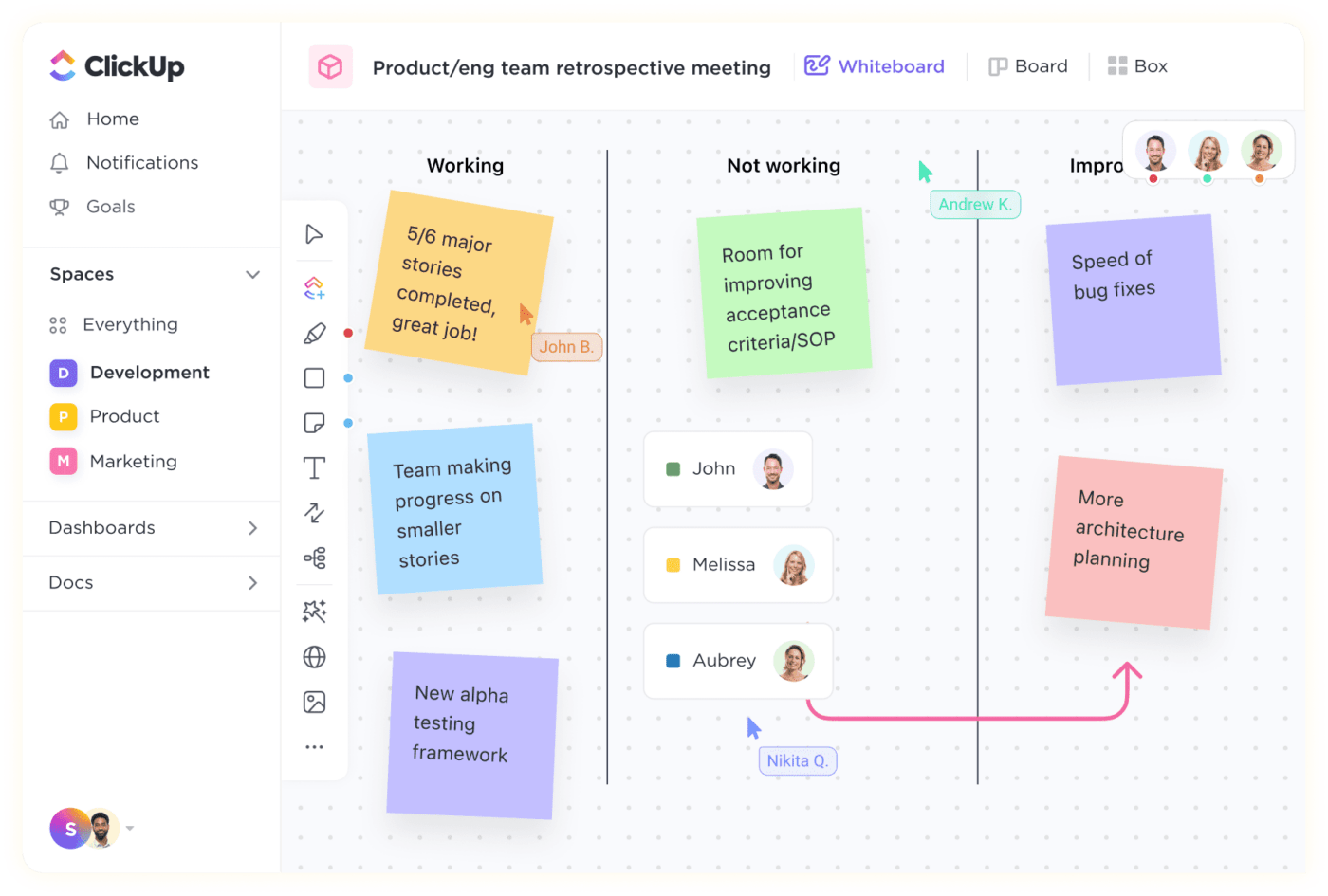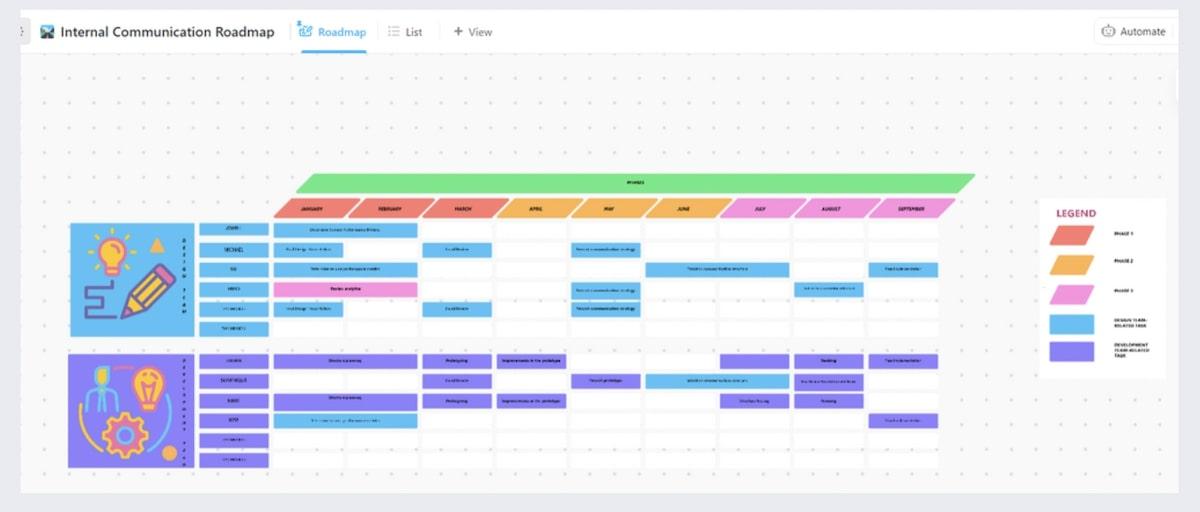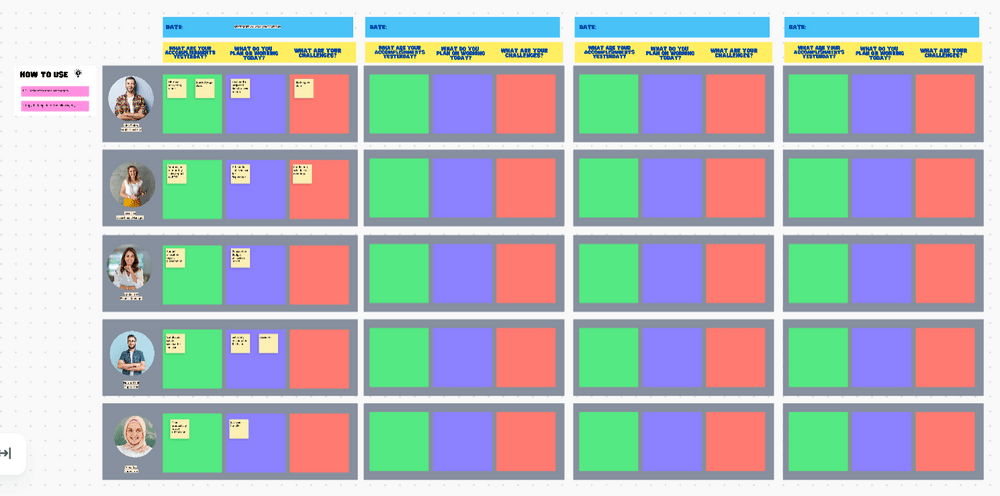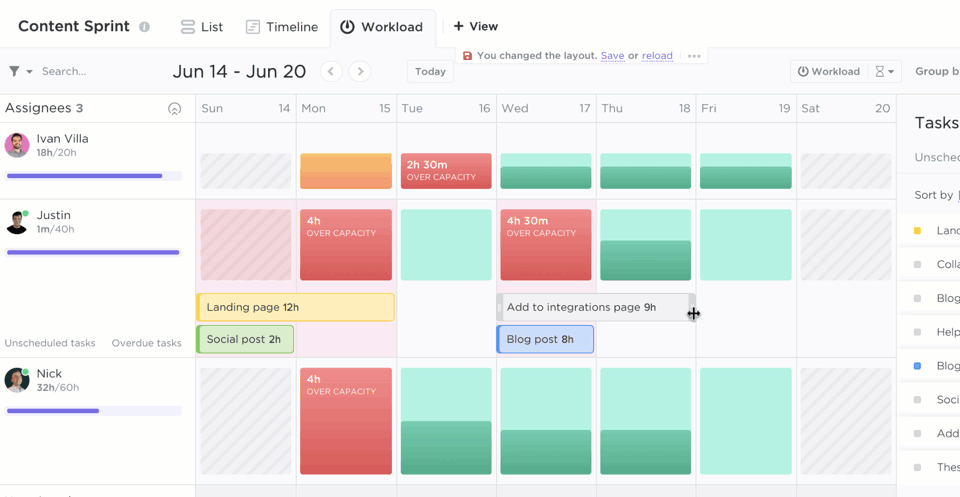مع استمرار تطور أنواع مختلفة من إعدادات العمل في العصر الحديث، أصبح التنوع في مكان العمل أكبر من أي وقت مضى. تعمل الشركات الآن داخل المكاتب الفعلية، وفي أماكن العمل عن بُعد بالكامل، و النماذج الهجينة التي تمزج بين الاثنين. مع انتشار فرق العمل في مواقع مختلفة أو مناطق زمنية مختلفة أو حتى مجرد طوابق مختلفة في مبنى المكاتب، يظل هناك تحدٍ واحد عالمي: التواصل الفعال بين الفريق.
فعلى عكس البيئات التقليدية حيث يمكن لدردشة سريعة أثناء استراحة لتناول القهوة أو اجتماع قصير في مبرد المياه أن يحل المشكلات أو يلهم أفكارًا جديدة، تتطلب نماذج أماكن العمل المتنوعة اليوم آليات أكثر تنظيماً للتواصل. فالتفاعل وجهاً لوجه، مهما كان مرغوباً، ليس دائماً خياراً متاحاً.
يتضخم التحدي المتمثل في التواصل الواضح والفعال في هذه النماذج بيئات العمل المتنوعة . لكن الحل ليس ببساطة مجرد الاتفاق على التواصل بشكل أفضل. وبدلاً من ذلك، يتطلب الأمر ممارسات مدروسة واستخدام أدوات محددة مصممة لسد فجوة الفصل المادي.
في هذه المدونة، سوف ندرس في هذه المدونة سبب أهمية التواصل الجماعي في بيئات العمل المختلفة ونستكشف عشر استراتيجيات لتحسينه، بغض النظر عما إذا كان فريقك في مكتب، أو موزعين في جميع أنحاء العالم، أو يستخدم مزيجًا من الاثنين معًا. دعونا نتعمق في الأمر!
ما هو التواصل الجماعي في مكان العمل؟
التواصل الجماعي هو تبادل المعلومات بين شخصين أو أكثر يعملون على تحقيق أهداف مشتركة. تعاون الفريق والتواصل يمكن أن يأتي بأشكال مختلفة، مثل تطبيقات الدردشة والبريد الإلكتروني, برامج إدارة المشاريع أو مكالمات الفيديو أو الاجتماعات الشخصية أو الرسائل الإخبارية أو المحادثات البسيطة وجهاً لوجه.
قد يختلف أسلوب تواصل فريقك في العمل. ولكن في النهاية، يتضمن مشاركة الأفكار, تحسين حلقات التغذية الراجعة و تحديثات المشروع مع تعزيز التعاون وتعزيز الشفافية. التواصل الفعال بين الفريق أمر بالغ الأهمية لتعزيز الإنتاجية, تحسين معنويات الفريق ودفع عجلة إنجاز المشروع بنجاح.
لماذا يعتبر التواصل الجماعي مهمًا؟
التواصل الجماعي هو شريان الحياة في أي بيئة مهنية، سواء كان ذلك عن بُعد بالكامل، أو في منشأة في الموقع، أو في مكان عمل مختلط. إنه المفتاح لتحويل المساهمين الأفراد إلى وحدة متماسكة، وتعزيز ثقافة عمل صحية تقدر التعاون والحوار.
حتى قبل التحول المعاصر نحو العمل عن بُعد، أشارت الدراسات إلى أن الموظفين يقضون جزءًا كبيرًا من وقتهم في التعاون - وهو مؤشر واضح على الدور الحاسم الذي يلعبه التواصل في أي بيئة عمل. في فرق العمل المتنوعة التي تمتد عبر مواقع ومناطق زمنية مختلفة، أو حتى في بيئة مكتبية واحدة، يظل التواصل حاجة أساسية ثابتة.
وغالبًا ما يؤدي التواصل غير الكافي أو غير الفعال إلى انخفاض مستويات الإنتاجية، حيث يكافح الموظفون لفهم أدوارهم وأهدافهم ومهامهم دون توجيهات أو ملاحظات واضحة. تشير الأبحاث إلى أن العديد من العاملين يشعرون بأن أداءهم يتراجع بسبب ضعف استراتيجيات التواصل داخل أماكن عملهم. ثغرات التواصل يمكن أن تؤثر أيضًا على تصور قيادة الشركة. فبدون الشفافية وقنوات الاتصال المفتوحة، قد يفقد الموظفون الثقة في قادتهم مما يؤدي إلى انخفاض الروح المعنوية والحافز.
وباختصار، فإن تحسين التواصل الجماعي يسمح للجميع بالحصول على الكعكة وأكلها أيضًا. 🎂
أنواع التواصل الجماعي
يمكن أن تؤثر طريقة تواصل فريقك بشكل كبير على مدى فعالية تعاون فريقك. هناك طريقة رائعة لتجميع أشكال التواصل المختلفة من خلال كيفية تقديم المعلومات.
فيما يلي قائمة بأنواع التواصل الأربعة وكيفية استخدام الفرق لها:
- التواصل اللفظي: عندما يتحدث أعضاء فريقك مع بعضهم البعض ويستخدمون الكلمات لنقل الأفكار، فإنهم يتواصلون شفهياً. ولأن الجميع يتواصلون عن بُعد، قد يكون ذلك مكالمة هاتفية أو مكالمة فيديو 📣
- التواصل غير اللفظي: غالبًا ما يتم إغفال أقوى أشكال التواصل البشري، وهو التواصل غير اللفظي، في أماكن العمل التي تعتمد على التواصل الرقمي. يمكن أن تكون التصرفات مثل لغة الجسد، ونبرة الصوت، والإيماءات، والتواصل بالعينين، وخاصة تعابير الوجه، أدلة قوية على ما يعنيه شخص ما. أظهرت إحدى الدراسات أن ما يصل إلى93% من التواصل يمكن أن يكون غير لفظيحيث يتم نقل 38% من التواصل من خلال نبرة الصوت و55% من خلال تعابير الوجه ولغة الجسد. هذا هو السبب في أن رؤية بعضنا البعض مهمة جدًا للتواصل في مكان العمل 👍
- التواصل الكتابي: عندما تكون الكلمات مكتوبة، فإنك تشارك في التواصل الكتابي. بالنسبة للعمل عن بُعد، نستخدم الإنترنتأدوات التواصل مثل رسائل البريد الإلكتروني والمستندات والملاحظات وتطبيقات الدردشة لإجراء اتصالات جماعية مكتوبة. إحدى مزايا التواصل المكتوب هي أنه يمكنك الرجوع إليها متى شئت ولا تضطر إلى الاعتماد على الذاكرة ✒️
- التواصل المرئي: الكلمات رائعة، ولكن كما يقول المثل، يمكن أن تساوي الصورة ألف كلمة. في مجال الأعمال التجارية، يكون نقل المعلومات المعقدة بصرياً أكثر فعالية. نستخدم المخططات أو مقاطع الفيديو أو الرسوم البيانية أو الرسوم البيانية أو الرسوم البيانية أو الصور أو مزيج من هذه الطرق ليس فقط لنقل الحقائق، بل لنقل كيفية ارتباط هذه الحقائق ببعضها البعض 🖼️

قم بالعصف الذهني والتخطيط ووضع الاستراتيجيات وتبسيط الاتصالات في الوقت الفعلي لشحن المشاريع بشكل أسرع باستخدام لوحات ClickUp Whiteboards
كيفية تحسين تواصل الفريق باستخدام 10 استراتيجيات
والآن بعد أن عرفنا ماذا ولماذا وكيف، دعنا نبدأ في كسر تلك العزلات ومناقشة بعض الطرق التي أثبتت جدواها لزيادة إنتاجية فريقك.
عندما تقرأ هذه القائمة، انظر إليها من حيث المجالات التي يعاني فيها فريقك والمجالات التي يبلي فيها بلاءً حسناً. هل تحتاج إلى تحسين سرعة التواصل أو الدقة؟ أو ربما تحتاج إلى استعادة تلك الشرارة الإبداعية؟
يجب أن تساعدك هذه الاستراتيجيات العشر الفعالة في التواصل في كل موقف تقريباً.
1. ضع إرشادات حول نوع التواصل الذي يجب استخدامه
لكل شخص أساليب تواصل مختلفة. فقد يستخدم شخص ما الرسائل الفورية دائمًا، بينما لا يتواصل شخص آخر إلا من خلال الاتصال بالآخرين والتحدث معهم. على الرغم من أهمية وجود بعض المرونة، إلا أن الاتساق بين فريقك يمكن أن يخلق بيئة عمل أكثر كفاءة.

تعتبر استراتيجية وخطة عمل الاتصالات الداخلية من ClickUp هي الإعداد المرئي المثالي لتوثيق الأمور ووضعها موضع التنفيذ
أولاً، قم أولاً بتقييم معايير الاتصال الحالية باستخدام ClickUp نموذج استراتيجية وخطة عمل الاتصال الداخلي . وهو يوفر إطار عمل لرسم خريطة مؤسستك، والتقاط أنماط التواصل الحالية لديك، وجمع احتياجات أصحاب المصلحة، وتوثيق التحديات، وتحديد خارطة الطريق الجديدة.
بمجرد حصولك على خارطة الطريق الخاصة بك، ضع مبادئ توجيهية واضحة ووثقها. قم بتوحيد أنواع المعلومات التي تستخدم وضع الاتصال، مثل انقر فوق اللوحات البيضاء للعصف الذهني، والدردشة للمشكلات العاجلة، والتعليقات على المهام للرسائل غير العاجلة.
ولأننا نعلم أن البريد الإلكتروني في بعض الأحيان سيكون وسيلة الاتصال المفضلة لديك، يمكنك إرسال واستقبال رسائل البريد الإلكتروني في أي مكان في ClickUp .
2. التجمع بشكل متكرر للاجتماعات الدائمة
هناك العديد من أنواع اجتماعات الفريق المختلفة التي تربط فرق العمل عن بعد، ولكل منها مكانها. يعد اجتماع الوقوف في مكان واحد بالنسبة للعديد من المجموعات التي تحركها المشاريع. يُعقد عادةً مرة واحدة في اليوم، ويأتي الاسم من ممارسة الوقوف لإبقاء الاجتماعات قصيرة.
في الاجتماع التصاعدي، تتنقل بين أعضاء الفريق واحدًا تلو الآخر، ويتحدث كل شخص عما عمل عليه منذ الاجتماع الأخير، وما لديهم على جدول أعمالهم في ذلك اليوم، وأي تحديات يواجهونها. إنها أداة قياسية في طريقة تطوير البرمجيات الرشيقة .

الهدف من اجتماع الاستعداد اليومي هو المساعدة في تنسيق الفريق. تساعد حلقة التغذية الراجعة السريعة هذه الفرق على المواءمة والبقاء على المسار الصحيح، وهو ما يشبه التجمع في كرة القدم. إذا ظهرت مشكلة ما، فيمكنك معالجتها بسرعة وإبقاء المشاريع على المسار الصحيح
يمكن أن تكون اجتماعات الاستعداد ضرورية لما يلي الفرق متعددة الوظائف الذين ليس لديهم مفردات مشتركة، مما يمنح الجميع فرصة أفضل لفهم ما يقوم به أقرانهم في الأدوار الأخرى. تساعد عمليات الوقوف الفرق على التواصل بفعالية من خلال تعزيز التواصل والتنظيم والمواءمة على أهداف التواصل .
ومع ذلك، يمكن أن يكون التخطيط لها عملاً روتينيًا باستخدام أدوات قديمة. قالب اجتماع الاستعداد اليومي من ClickUp يبسّط هذه العملية من خلال توفير مركز مركزي للتخطيط وتدوين الملاحظات وتتبع التقدم المحرز، وقوائم مراجعة فردية لضمان الدقة، وموقع واحد للتحديثات في الوقت الفعلي لإبقاء الجميع على اطلاع.
3. احترام احتياجات التواصل المختلفة
سواء في مكالمة Zoom أو في سلسلة محادثات Slack، من السهل أن يهيمن بعض أعضاء الفريق على المحادثة ولا يُسمع صوت الآخرين. ومن الشائع أيضًا أن يتشتت انتباه بعض المشاركين أو لا يحضرون المحادثة.
ومع ذلك، ربما لا يكون ذلك بسبب عدم اهتمامهم!
في حين أن الأمر متروك للقيادة لتشجيع مشاركة الموظفين وتعاون الفريق، إلا أن بعض الموظفين ببساطة انطوائيون أو يشعرون بالارتباك في المجموعات، ولا عيب في ذلك. تأكد من أنهم يعرفون أن بإمكانهم مشاركة أفكارهم بأي شكل: بعد الاجتماع كتابيًا، أو في مستندات تعاونية، أو عبر التعليقات أو الدردشة، أو مباشرة إليك.
عزز التواصل والتعاون داخل فرق العمل باستخدام ClickUp Chat View
بالنسبة للأشخاص الجدد أو الذين يعانون من الفتور المفاجئ، قد ترغب في تحديد موعد للتحقق من وجود أي شيء يعيقهم. يعرف المديرون الجيدون أن هناك أحياناً مشكلة أكبر، مثل رفض أعضاء الفريق الآخرين لأفكارهم في جلسات العصف الذهني أو الشعور بأن صوتهم لا يُسمع أبداً.
في إحدى الدراسات 50% من العاملين أفادوا بالتزامهم الصمت في العمل بشأن مخاوفهم. والحقيقة هي أنه قد يكون عليك إجراء تغيير أو التحدث مع الموظفين الآخرين لخلق بيئة أكثر شمولاً حيث يعرف الناس أنه من الآمن التحدث عن مخاوفهم.

يتيح ClickUp Docs التنسيق المنسق و أوامر الشرطة المائلة للعمل بكفاءة أكبر
من المفيد أيضًا تحديد التوقعات في أسلوب تواصلك وتوثيقها لـ تعزيز إنتاجية الفريق . يمكن أن يشمل ذلك أشياء مثل تشغيل الكاميرا دائمًا للاجتماعات الافتراضية والرد على جميع رسائل البريد الإلكتروني أو محادثات الفريق في غضون وقت معين.
ستجعل أعضاء الفريق يشعرون بأن صوتهم مسموع بينما تقلل من قلق أولئك الذين يحبون القواعد والتوجيهات. وبغض النظر عن الطريقة التي تتعامل بها مع الاجتماعات الجماعية، فإن الأمر يتعلق بشعور الجميع بأن مساهماتهم مهمة وإزالة الحواجز التي تحول دون التواصل المفتوح.
مكافأة: التواصل مع الموظفين عن طريق
_/مرجع/ https://clickup.com/blog/skip-level-meeting// استخدام الاجتماعات على مستوى التخطي %/%href/_
!
4. تطوير مهارة التواصل المهمة المتمثلة في الاستماع
يتمحور تواصل الفريق حول تبادل المعلومات بين الأعضاء، وليس مجرد إرسال رسائل البريد الإلكتروني. ولهذا السبب يحتاج كل عضو في الفريق إلى أن يكون منفتحًا على الاستماع بقدر ما يتحدث. وهذا يشمل الانتباه إلى القرائن غير اللفظية وقراءة المحتوى المكتوب بعناية.
اضبط النغمة من خلال الاستماع الفعال - وهذا يعني أنه بدلاً من التفكير فيما ستقوله بعد ذلك أثناء حديث شخص ما، قم بتصفية ذهنك واستمع حقًا لما يقوله. اطرح أسئلة المتابعة لتجعلهم يستمرون في الحديث بدلاً من تحويل الأضواء إلى فكرتك الخاصة.
إذا كان فريقك يعاني من صعوبة في الاستماع النشط، فقم بتنظيم اجتماع أكثر تنظيماً حيث يشارك أحد الموظفين فكرة ما ويجب طرح ثلاثة أسئلة متابعة قبل الانتقال إلى الفكرة التالية. حتى لو كانت الفكرة سيئة حقًا، سيعرف عضو الفريق أن صوته سيكون مسموعًا. 📣
يعد الاستماع مهارة صعبة حتى بالنسبة للمديرين التنفيذيين، لذا قد ترغب في التفكير في التخطيط لبعض التدريب على الاستماع النشط.

تضمن التعليقات المعينة ما يلي عناصر العمل لا تضيع، بغض النظر عن مكان إنشائها
إذا كنت تجتمع افتراضيًا أو تقوم بالعصف الذهني معًا في الوقت الفعلي ، استخدم تعليقات ClickUp في مشاريعك كوسيلة لتشجيع الاستماع لبعضكم البعض. يمكنك تعيين المواضيع وذكر الأشخاص في التعليقات لجذب فريقك لقراءة ما يقوله الآخرون في التعليقات والتفكير فيه.
هذا مفيد بشكل خاص للفرق المنتشرة في مناطق زمنية مختلفة.
5. وضع جدول زمني واضح مع مخرجات واضحة
يحتاج كل فرد في الفريق إلى معرفة مخرجات المشروع وموعد استحقاقها. من الصعب الوفاء بهذه المواعيد النهائية إذا كان هناك سوء تفاهم حول ماهية الأشياء التي يجب إنجازها ومتى يجب إنجازها.
هناك طريقة رائعة لإيصال هذه المعلومات إلى الفريق بأكمله وهي العمل في أداة تعاون تتعامل مع جدولة المشروع بسهولة، مثل منصة إدارة المشاريع المتكاملة من ClickUp. يمكن لكل عضو من أعضاء الفريق تصور مهامه بالطريقة التي تناسبه، ويمكن تعيين طرق عرض ClickUp على العامة أو الخاصة لتحسين الشفافية.
يحتوي ClickUp أيضًا على الكثير من قوالب المشاريع القابلة للتسليم مع حقول مخصصة مبنية مسبقًا لبدء العمل بشكل أسرع.
6. تعيين المهام وتتبع التقدم المحرز
يتطلب إنجاز مخرجاتك في الوقت المحدد مشاركة ما يجب إنجازه، ومن يقوم به، وأين تقف الأمور. مع وجود فريق عمل عن بُعد، تحتاج إلى أداة رقمية تدعم تعيينات المهام وتتيح للفريق رؤية الحالة والتفاعل بشكل تعاوني حول كل مهمة.
استخدم "عرض عبء العمل" في ClickUp لمعرفة من هو متقدم أو متأخر في إنجاز المهام وسحب وإسقاط المهام بسهولة لإعادة تخصيص الموارد

استخدم طريقة عرض عبء العمل في ClickUp لمعرفة من هو متقدم أو متأخر وسحب المهام وإفلاتها بسهولة لإعادة تخصيص الموارد
ابدأ بتقسيم مشروعك إلى مهام ومهام فرعية باستخدام ClickUp. أثناء قيامك بإنشاء مهام ClickUp يمكنك إضافة بيانات الحقول المخصصة، وتعيين أعضاء الفريق، وإنشاء تبعيات بين المهام.
يمكنك بعد ذلك تتبع التقدم من أكثر من 15 طريقة عرض قابلة للتخصيص. على سبيل المثال، تُظهر لك طريقة عرض النشاط في ClickUp من قام بماذا في المشروع، كما تُظهر لك طريقة عرض عبء العمل مقدار الوقت الذي ستستغرقه كل مهمة.
باستخدام ClickUp كمساحة عمل تعاونية، لن يضطر أحد إلى سؤال الفريق عمن يعمل على ماذا.
7. تدوين الملاحظات لتسجيل المناقشات
يعد التحدث عن الأمور طريقة رائعة لبناء التفاهم واتخاذ القرارات. من المؤكد أن أداة التواصل الافتراضي للفريق مثل Zoom أو Microsoft Teams أو Google Workspace تبسّط التواصل الشفهي. لكن الذاكرة البشرية غير كاملة، ويمكن أن تدخل بنود إجراءات الاجتماع في أذن وتخرج من الأذن الأخرى في بعض الأحيان.
أفضل طريقة للتأكد من تسجيل مناقشات فريقك هي تدوين الملاحظات وتخزينها في مساحة العمل الجماعية الخاصة بك. تتضمن كل مهمة ولوحة بيضاء وخريطة ذهنية ومستند في ClickUp إمكانية إضافة تعليقات.
من السهل إضافة ملاحظات عبر مشروعك وإشراك الفريق بأكمله في العملية. ولأن التعليقات متعددة الوسائط في ClickUp، يمكنك إضافة الصور والملفات والمقاطع الصوتية وحتى تسجيلات الشاشة .
تواصل بشكل أسرع مع ClickUp Clips وقل وداعاً للاجتماعات غير الضرورية
يتضمن ClickUp أيضًا أداة المفكرة حيث يمكنك تدوين الملاحظات بطريقتك أثناء العمل. يمكنك الارتباط بالأشخاص والمهام والمستندات حتى يظل كل شيء متصلاً. قم بتحويلها إلى مهمة أو مستند لمشاركتها مع فريقك عندما تكون مستعدًا.
أياً كانت الأداة التي تستخدمها، ابحث عن أداة تعاونية ومتاحة في أي مكان للحصول على تواصل أكثر انسيابية.
8. ضع ميزانية للاجتماعات الشخصية
من الشائع هذه الأيام أن يقوم الفريق بإجراء مقابلة مع عضو جديد وتوظيفه والعمل معه و أبداً لا يلتقي به شخصياً. لكن الأبحاث تُظهر أن الاجتماعات المباشرة وجهاً لوجه تخلق روابط أكثر قوة و يمكن أن يحسن أداء الفريق بنسبة 35% .
خصص بعض الميزانية لجمع الجميع في نفس المكان مرة أو مرتين في السنة.
أكثر من مجرد فرصة للعمل معًا في نفس المكان، يجب أن تركز التجمعات الشخصية على التواصل الاجتماعي والترابط بطرق أخرى. قم بتعيين شخص ما لتسهيل التفاعل وجدولة بناء الفريق ، واحرص دائمًا على أن يكون لديك وقت فراغ حيث يمكن للأشخاص التواصل على المستوى الشخصي.
حتى لو كان ذلك مرة واحدة فقط في السنة، فإن اجتماع الجميع معًا سيؤدي إلى بناء فريق أقوى يثقون ببعضهم البعض - وبالتالي يتواصلون بشكل أكثر فعالية.
_جرب هذه
_مراجع/ https://clickup.com/blog/team-building-apps// تطبيقات بناء الفريق *%/href/_
!
9. استخدام نظام بإشعارات قابلة للتكوين
إذا أنشأ شخص ما مستندًا مهمًا ووضعه في دليل دون إخبار أي شخص، فهناك احتمال حدوث انهيار في التواصل. لا يمكنك الاعتماد على أعضاء الفريق للتحقق من المهام طوال اليوم، كل يوم، وملاحظة التغييرات الدقيقة (ولكن المهمة).

خصص إشعاراتك لتنطلق تلقائيًا عند تغيير حالة المهمة في ClickUp
تعمل منصة التعاون مع إعدادات الإشعارات القابلة للتكوين على حل هذه المشكلة. ولأننا نعلم مدى أهمية التحكم في إشعاراتك، تأتي ClickUp مزودة بإمكانية تخصيص الإشعارات بالكامل .
يمكنك البدء باختيار الإجراءات التي ستنشئ رسائل، ثم تحديد المكان الذي ستصلك فيه الإشعارات، بما في ذلك الهاتف المحمول أو البريد الإلكتروني أو سطح المكتب أو المتصفح. إذا كنت تفضل التحكم في وقت تلقيك للرسائل، يمكنك تشغيل الملخصات اليومية أو إيقاف تشغيل الإشعارات أثناء نشاطك في تطبيق الويب.
10. العمل ضمن منصة تعاونية واحدة
عند العمل بشكل شخصي، فإن أفضل طريقة لـ تحقيق التعاون الجيد هو وضع الجميع في نفس الغرفة. يمكنك القيام بالشيء نفسه مع فريق العمل عن بُعد من خلال التأكد من أن جميع أعضاء فريقك يستخدمون نفس مجموعة الأدوات. إذا كانت مجموعة واحدة من العاملين على منصة مختلفة، فإن الأمر يشبه التواجد في غرفة مختلفة، فلا يمكن لأعضاء الفريق الآخرين رؤية ما يفعلونه.
إذا استطعت، استخدم حلاً تعاونياً واحداً يدعم جميع الميزات التي تحتاجها في مكان واحد. ClickUp هو أداة شاملة لتحل محل كل تلك الحلول المنفصلة. كل ميزة تعاونية بالكامل من أجل التواصل الفعال.
تعاون في الأفكار وأنشئ مستندات أو مواقع ويكي مذهلة مع صفحات متداخلة وخيارات تنسيق مخصصة لخرائط الطريق وقواعد المعرفة والمزيد
بدلاً من إرسال بريد إلكتروني للجميع لجمع الملاحظات وجعل شخص واحد يجمعها كلها في مستند، يمكنكم جميعاً تدوين الملاحظات على مستند ClickUp Doc واحد وإضافة تعليقات على أفكار بعضكم البعض، وتحويل أهم المهام إلى مهام ClickUp.
بالطبع، تحتاج أحياناً إلى العمل مع أدوات أخرى. نحن نتكامل مع أكثر من 1000 أداة أخرى لجعل يوم عملك أسهل. باستخدام ClickUp، يمكنك جمع الجميع في نفس الغرفة الافتراضية، والعمل كفريق واحد بنفس المعلومات والأهداف.
مهارات تواصل الفريق
إن إتقان التواصل الجماعي هو أكثر من مجرد معرفة كيفية وضع الجمل معًا أو إرسال بريد إلكتروني جماعي أسبوعي. فهو ينطوي على مهارات معينة يمكن أن تدفع إنتاجيتك الجماعية بشكل كبير، وتعزز الروح المعنوية، وتضمن سلاسة تنفيذ المشروع .
فيما يلي بعض مهارات التواصل الجماعي الأساسية التي يمكن أن تعزز طريقة عمل فريقك معًا:
الإصغاء الفعال: يتضمن ذلك فهم واستيعاب أفكار زملائك في الفريق، مما يؤدي إلى التعاون الإبداعي وحل النزاعات.
الوضوح والإيجاز: أن تكون واضحًا وموجزًا يجعل رسائلك مفهومة بسهولة، مما يمنع سوء التواصل.
التواصل غير اللفظي: يساعد التعرف على التغييرات في نبرة الصوت أو لغة الجسد على فهم المشاعر والمواقف من أجل تفاعلات أكثر تعاطفاً.
الذكاء العاطفي: فك شفرة مشاعر زملائك في الفريق والاستجابة لها يعزز المحادثات الأكثر صحة وحساسية.
حل المشاكل: تيسير إيجاد حلول للمشاكل، من خلال الحوار، يساهم بشكل مباشر في أداء الفريق بشكل أكثر سلاسة وديناميكيات متناغمة.
تقديم الملاحظات المحترمة: تقديم الملاحظات البناءة باحترام يمكن أن يحفز أعضاء الفريق ويحسن الأداء العام.
تعزيز الاحترام والانفتاح: تشجيع كل صوت مسموع يعزز الثقة ويقوي علاقات الفريق.
التواصل الكتابي الفعال: التواصل الكتابي الواضح والدقيق والخالي من الأخطاء يقلل من سوء الفهم.
المرونة والقدرة على التكيف: يساعد التكيف مع أساليب التواصل المتنوعة في تطوير علاقات أقوى وتفاهم متبادل.
الاستخدام المتقن لأدوات التواصل: إتقان استخدام أدوات التواصل مثل ClickUp يبسط العمليات ويعزز التعاون ويقلل من سوء الفهم.
الصبر: التحلي بالصبر في التواصل يعزز الحوار المهذب والتفاهم والهدوء أثناء المواقف المتوترة.
إدارة الوقت: بالنسبة للفرق المنتشرة عبر مناطق زمنية مختلفة، فإن إدارة التواصل لاحترام ساعات عمل الجميع تضمن التفاعل في الوقت المناسب وباحترام.
يمكن أن يساهم إتقان مهارات التواصل الجماعي هذه في خلق بيئة عمل أكثر انسجامًا وكفاءة وإنتاجية. يمكن أن يساعد تعزيز هذه القدرات داخل فريقك في تكوين روابط أقوى وتفاهم متبادل وثقة متبادلة - وهي مكونات أساسية للعمل الجماعي الناجح. تذكّر أن التواصل الفعال بين أعضاء الفريق لا يتحقق بين عشية وضحاها، فهو يتطور ويتحسن مع الوقت والجهد المستمر والممارسة. ولكن مع وجود هذه الأدوات تحت تصرفك، فأنت بالفعل على المسار الصحيح.
اجمع فريقك معًا من خلال التواصل الجماعي
نأمل أن تجد هذه الاستراتيجيات مفيدة في تمكين التواصل الفعال للفريق في مشروعك القادم. لقد بدأت بداية رائعة مع أدوات التواصل، ومنصة التعاون، وثقافة الشركة التي تركز على تعاون الفريق.
سواء كان فريقك يعمل عن بُعد أو في المكتب، تم تصميم ClickUp من الألف إلى الياء لإبقاء الفرق على نفس الصفحة والعمل على تحقيق نفس الأهداف. فهو يلتقط المعلومات وينقلها و يشجع العمل الجماعي في منصة واحدة تتكامل مع قنوات الاتصال الأكثر شيوعًا لعقد مؤتمرات الفيديو أو الدردشة أو إنشاء المستندات.
أفضل طريقة لمعرفة كيف يمكن لـ ClickUp مساعدتك في القضاء على ضعف التواصل بين فريقك هي جربه مجانًا اليوم .



